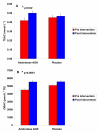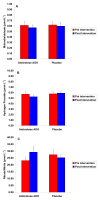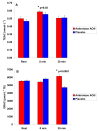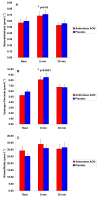Effect of Ambrotose AO® on resting and exercise-induced antioxidant capacity and oxidative stress in healthy adults - PubMed (original) (raw)
Randomized Controlled Trial
Effect of Ambrotose AO® on resting and exercise-induced antioxidant capacity and oxidative stress in healthy adults
Richard J Bloomer et al. Nutr J. 2010.
Abstract
Background: The purpose of this investigation was to determine the effects of a dietary supplement (Ambrotose AO®) on resting and exercise-induced blood antioxidant capacity and oxidative stress in exercise-trained and untrained men and women.
Methods: 25 individuals (7 trained and 5 untrained men; 7 trained and 6 untrained women) received Ambrotose AO® (4 capsules per day = 2 grams per day) or a placebo for 3 weeks in a random order, double blind cross-over design (with a 3 week washout period). Blood samples were collected at rest, and at 0 and 30 minutes following a graded exercise treadmill test (GXT) performed to exhaustion, both before and after each 3 week supplementation period. Samples were analyzed for Trolox Equivalent Antioxidant Capacity (TEAC), Oxygen Radical Absorbance Capacity (ORAC), malondialdehyde (MDA), hydrogen peroxide (H2O2), and nitrate/nitrite (NOx). Quality of life was assessed using the SF-12 form and exercise time to exhaustion was recorded. Resting blood samples were analyzed for complete blood count (CBC), metabolic panel, and lipid panel before and after each 3 week supplementation period. Dietary intake during the week before each exercise test was recorded.
Results: No condition effects were noted for SF-12 data, for GXT time to exhaustion, or for any variable within the CBC, metabolic panel, or lipid panel (p > 0.05). Treatment with Ambrotose AO® resulted in an increase in resting levels of TEAC (p = 0.02) and ORAC (p < 0.0001). No significant change was noted in resting levels of MDA, H2O2, or NOx (p > 0.05). Exercise resulted in an acute increase in TEAC, MDA, and H2O2 (p < 0.05), all which were higher at 0 minutes post exercise compared to pre exercise (p < 0.05). No condition effects were noted for exercise related data (p > 0.05), with the exception of ORAC (p = 0.0005) which was greater at 30 minutes post exercise for Ambrotose AO® compared to placebo.
Conclusion: Ambrotose AO® at a daily dosage of 4 capsules per day increases resting blood antioxidant capacity and may enhance post exercise antioxidant capacity. However, no statistically detected difference is observed in resting or exercise-induced oxidative stress biomarkers, in quality of life, or in GXT time to exhaustion.
Figures
Figure 1
Timeline of study to investigate the effect of Ambrotose AO® on resting and exercise-induced antioxidant capacity and oxidative stress in healthy adults.
Figure 2
Serum Trolox Equivalent Antioxidant Capacity (TEAC) and Oxygen Radical Absorbance Capacity (ORAC) of 25 subjects (12 men and 13 women) before and following three weeks of supplementation with Ambrotose AO® at a dosage of 4 capsules per day and placebo (cross-over design with a three week washout between conditions). Values are mean ± SEM. For TEAC: Condition × time interaction (p = 0.17) * Paired contrast between pre and post intervention for Ambrotose AO® (p = 0.02) For ORAC: Condition × time interaction (p = 0.01) * Paired contrast between pre and post intervention for Ambrotose AO® (p < 0.0001)
Figure 3
Plasma Malondialdehyde (MDA), Hydrogen Peroxide (H2O2), and Nitrate/Nitrite (NOx) of 25 subjects (12 men and 13 women) before and following three weeks of supplementation with Ambrotose AO® at a dosage of 4 capsules per day and placebo (cross-over design with a three week washout between conditions). Values are mean ± SEM. For MDA: Condition × time interaction (p = 0.77) Paired contrast between pre and post intervention for Ambrotose AO® (p = 0.61) For H2O2: Condition × time interaction (p = 0.53) Paired contrast between pre and post intervention for Ambrotose AO® (p = 0.41) For NOx: Condition × time interaction (p = 0.11) Paired contrast between pre and post intervention for Ambrotose AO® (p = 0.12)
Figure 4
Serum Trolox Equivalent Antioxidant Capacity (TEAC) and Oxygen Radical Absorbance Capacity (ORAC) of 25 subjects (12 men and 13 women) before and at 0 and 30 minutes after a graded exercise treadmill test to exhaustion, before and following three weeks of supplementation with Ambrotose AO® at a dosage of 4 capsules per day and placebo (cross-over design with a three week washout between conditions). Values are mean ± SEM. For TEAC: *Time effect (p = 0.02) For ORAC: Condition × time interaction (p < 0.0001) * Paired contrast between Ambrotose AO® and placebo (p < 0.0001)
Figure 5
Plasma Malondialdehyde (MDA), Hydrogen Peroxide (H 2 O 2 ), and Nitrate/Nitrite (NOx) of 25 subjects (12 men and 13 women) before and at 0 and 30 minutes after a graded exercise treadmill test to exhaustion, before and following three weeks of supplementation with Ambrotose AO® at a dosage of 4 capsules per day and placebo (cross-over design with a three week washout between conditions). Values are mean ± SEM. For MDA: *Time effect (p = 0.05) For H2O2: *Time effect (p < 0.0001)
Similar articles
- Impact of short-term dietary modification on postprandial oxidative stress.
Bloomer RJ, Trepanowski JF, Kabir MM, Alleman RJ Jr, Dessoulavy ME. Bloomer RJ, et al. Nutr J. 2012 Mar 21;11:16. doi: 10.1186/1475-2891-11-16. Nutr J. 2012. PMID: 22433080 Free PMC article. - A forced titration study of the antioxidant and immunomodulatory effects of Ambrotose AO supplement.
Myers SP, Stevenson L, Cheras PA, O'Connor J, Brooks L, Rolfe M, Conellan P, Morris C. Myers SP, et al. BMC Complement Altern Med. 2010 Apr 30;10:16. doi: 10.1186/1472-6882-10-16. BMC Complement Altern Med. 2010. PMID: 20433711 Free PMC article. Clinical Trial. - High-fat feeding, but not strenuous exercise, increases blood oxidative stress in trained men.
McCarthy CG, Farney TM, Canale RE, Dessoulavy ME, Bloomer RJ. McCarthy CG, et al. Appl Physiol Nutr Metab. 2013 Jan;38(1):33-41. doi: 10.1139/apnm-2012-0222. Epub 2013 Jan 1. Appl Physiol Nutr Metab. 2013. PMID: 23368826 Clinical Trial. - The impact of intensified training with a high or moderate carbohydrate feeding strategy on resting and exercise-induced oxidative stress.
Wadley AJ, Killer SC, Svendsen IS, Gleeson M. Wadley AJ, et al. Eur J Appl Physiol. 2015 Aug;115(8):1757-67. doi: 10.1007/s00421-015-3162-4. Epub 2015 Mar 31. Eur J Appl Physiol. 2015. PMID: 25822694 Review. - Effects of High Intensity Exercise on Oxidative Stress and Antioxidant Status in Untrained Humans: A Systematic Review.
Lu Y, Wiltshire HD, Baker JS, Wang Q. Lu Y, et al. Biology (Basel). 2021 Dec 4;10(12):1272. doi: 10.3390/biology10121272. Biology (Basel). 2021. PMID: 34943187 Free PMC article. Review.
Cited by
- An Assessment of the Glyconutrient Ambrotose™ on Immunity, Gut Health, and Safety in Men and Women: A Placebo-Controlled, Double-Blind, Randomized Clinical Trial.
Bloomer RJ, Butawan M, van der Merwe M, Keating FH. Bloomer RJ, et al. Nutrients. 2020 Jun 11;12(6):1751. doi: 10.3390/nu12061751. Nutrients. 2020. PMID: 32545396 Free PMC article. Clinical Trial. - The effect of dietary supplements on the quality of life of retired professional football players.
Sinnott R, Maddela RL, Bae S, Best T. Sinnott R, et al. Glob J Health Sci. 2012 Nov 22;5(2):13-26. doi: 10.5539/gjhs.v5n2p13. Glob J Health Sci. 2012. PMID: 23445692 Free PMC article. Clinical Trial. - A 21 day Daniel Fast improves selected biomarkers of antioxidant status and oxidative stress in men and women.
Bloomer RJ, Kabir MM, Trepanowski JF, Canale RE, Farney TM. Bloomer RJ, et al. Nutr Metab (Lond). 2011 Mar 18;8:17. doi: 10.1186/1743-7075-8-17. Nutr Metab (Lond). 2011. PMID: 21414232 Free PMC article. - Increase of pro-oxidants with no evidence of lipid peroxidation in exhaled breath condensate after a 10-km race in non-athletes.
Araneda OF, Urbina-Stagno R, Tuesta M, Haichelis D, Alvear M, Salazar MP, García C. Araneda OF, et al. J Physiol Biochem. 2014 Mar;70(1):107-15. doi: 10.1007/s13105-013-0285-0. Epub 2013 Aug 27. J Physiol Biochem. 2014. PMID: 23979922 - Antioxidant supplementation during exercise training: beneficial or detrimental?
Peternelj TT, Coombes JS. Peternelj TT, et al. Sports Med. 2011 Dec 1;41(12):1043-69. doi: 10.2165/11594400-000000000-00000. Sports Med. 2011. PMID: 22060178 Review.
References
- Halliwell B. Oxygen radicals: a commonsense look at their nature and medical importance. Med Biol. 1984;62:71–77. - PubMed
- Bloomer RJ, Goldfarb AH. Anaerobic exercise and oxidative stress: a review. Can J Appl Physiol. 2004;29:245–263. - PubMed
- Droge W. Free radicals in the physiological control of cell function. Physiol Rev. 2002;82:47–95. - PubMed
Publication types
MeSH terms
Substances
LinkOut - more resources
Full Text Sources
Other Literature Sources
Medical




